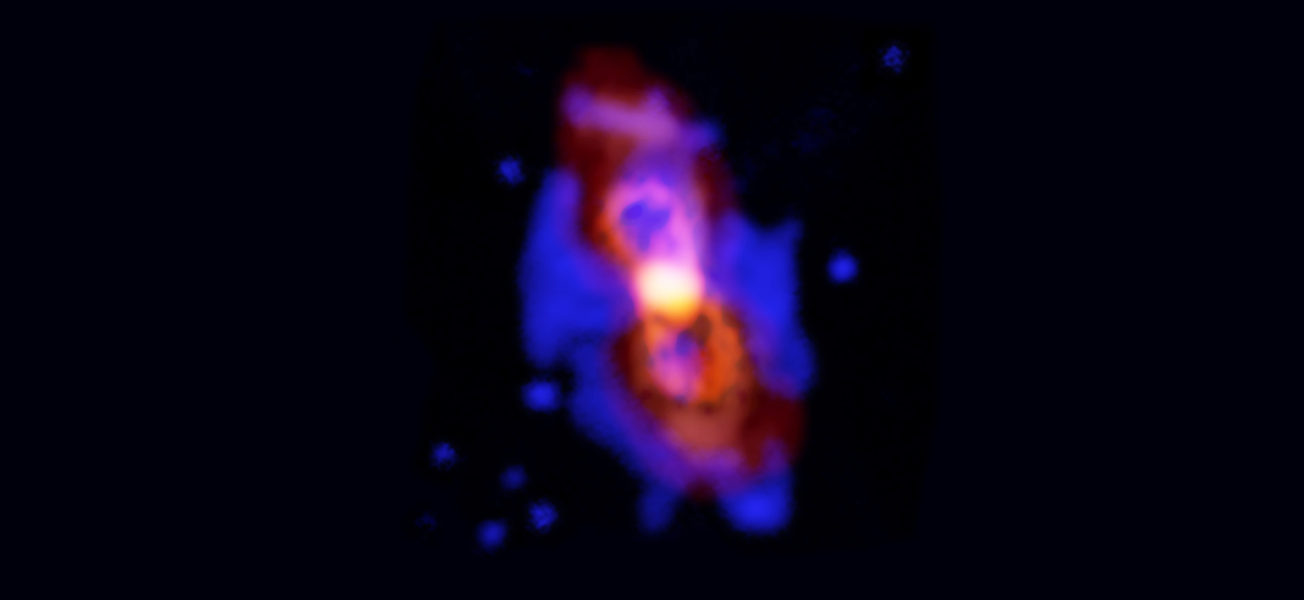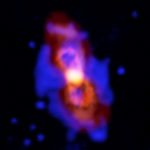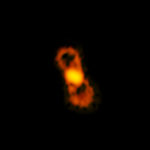Pair of Colliding Stars Spill Radioactive Molecules into Space
30 July, 2018 / Read time: 7 minutes
Scientific PaperAstronomers have made the first definitive detection of a radioactive molecule in interstellar space: a form, or isotopologue of aluminum monofloride (26AlF). The new data – made with ALMA and the NOEMA radio telescopes – reveal that this radioactive isotopologue was created by the collision of two stars, a tremendously rare cosmic event that was witnessed on Earth as a “new star,” or nova, in the year 1670.
When two Sun-like stars collide, the result can be a spectacular explosion and the formation of an entirely new star. One such event was seen from Earth in 1670. It appeared to observers as a bright, red “new star.” Though initially visible with the naked eye, this burst of cosmic light quickly faded and now requires powerful telescopes to see the remains of this merger: a dim central star surrounded by a halo of glowing material flowing away from it.
Approximately 348 years after this event, an international team of astronomers using ALMA and the NOEMA (Northern Extended Millimeter Array) radio telescopes studied the remains of this explosive stellar merger — known as CK Vulpeculae (CK Vul) — and discovered the clear and convincing signature of a radioactive version of aluminum (26Al, an atom with 13 protons and 13 neutron) bound with atoms of fluorine, forming 26-aluminum monofluoride (26AlF).
This is the first molecule bearing an unstable radioisotope definitively detected outside of our solar system. Unstable isotopes have an excess of nuclear energy and eventually decay into a stable, less-radioactive form. In this case, the 26-aluminum (26Al) decays to 26-magnesium (26Mg).
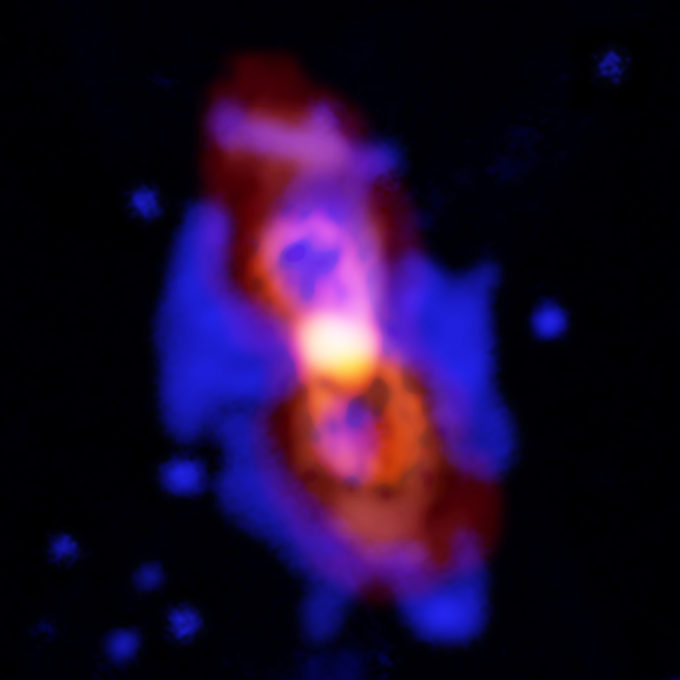
Composite image of CK Vul, the remains of a double-star collision. This impact launched radioactive molecules into space, as seen in the orange double-lobe structure at the center. This is an ALMA image of 27-aluminum monofluoride, but the rare isotopic version of AlF resides in the same region. The red, diffuse image is an ALMA image of the more extended dust in the region. The blue is optical hydrogen emission from the Gemini observatory. Credit: ALMA (ESO/NAOJ/NRAO), T. Kamiński & M. Hajduk; Gemini, NOAO/AURA/NSF; NRAO/AUI/NSF, B. Saxton
“The first solid detection of this kind of radioactive molecule is an important milestone in our exploration of the cool molecular universe,” said Tomasz Kamiński, an astronomer with the Harvard-Smithsonian Center for Astrophysics in Cambridge, Mass., and lead author on a paper appearing in Nature Astronomy.
The researchers detected the unique spectral signature of these molecules in the debris surrounding CK Vul, which is approximately 2,000 light-years from Earth. As these molecules spin and tumble through space, they emit a distinctive fingerprint of millimeter-wavelength light, a process known as “rotational transition.” Astronomers consider this the “gold standard” for molecular detections.
The characteristic molecular fingerprints are usually taken from laboratory experiments. In the case of 26AlF, this method is not applicable because 26-aluminum is not present on Earth. Laboratory astrophysicists from the University of Kassel/Germany therefore used the fingerprint data of stable and abundant 27AlF molecules to derive accurate data for the rare 26AlF molecule. “This method of extrapolation is based on the so-called Dunham approach,” explained Alexander Breier from the Kassel team. “It allows researchers to precisely calculate the rotational transitions of 26AlF with an accuracy far beyond the needs of astronomical observers.”
The observation of this particular isotopologue provides fresh insights into the merger process that created CK Vul. It also demonstrates that the deep dense inner layers of a star, where heavy elements and radioactive isotopes are forged, can be churned up and cast into space by stellar collisions. “We are observing the guts of a star torn apart three centuries ago by a collision,” observed Kamiński. “How cool is that?”
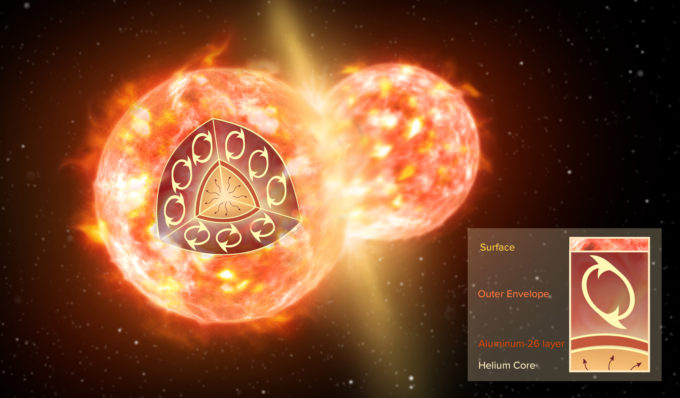
Artist impression of the collision of two stars, like the ones that formed CK Vul. The inset illustrates the inner structure of one red giant before the merger. A thin layer of 26-aluminum (brown) surrounds a helium core. An extended convective envelope (not to scale), which forms the outermost layer of the star, can mix material from inside the star to the surface, but it never reaches deep enough to dredge 26-aluminum up to the surface. Only a collision with another star can disperse 26-aluminum. Credit: NRAO/AUI/NSF; S. Dagnello
The astronomers also determined that the two stars that merged were relatively low-mass, with one being a red giant star with a mass somewhere between 0.8 and 2.5 times that of our Sun.
“This first direct observation of this isotope in a stellar-like object is also important in the broader context of the galactic chemical evolution,” noted Kamiński. “This is the first time an active producer of the radioactive nuclide 26Al has been directly observationally identified.”
It has been known for decades that there is about three entire Suns’ worth of 26Al spread across the Milky Way. But these observations, made at gamma-ray wavelengths, could only identify that the signal was there; they couldn’t pinpoint individual sources and it was unclear how the isotopes got there.
With current estimates on the mass of 26Al in CK Vul (about a quarter the mass of Pluto) and the rather rare occurrence of mergers such as this, it seems rather unlikely that mergers are solely responsible for this galactic radioactive material, the astronomers conclude.
However, ALMA and NOEMA can only detect the amount of 26Al bound with fluorine. The actual mass of 26Al in CK Vul (in atomic form) may be much greater. It is also possible that other merger remnants may have far greater amounts. Astronomers may also have underestimated the current merger rates in the Milky Way. “So this is not a closed issue and the role of mergers may be non-negligible,” speculated Kamiński.
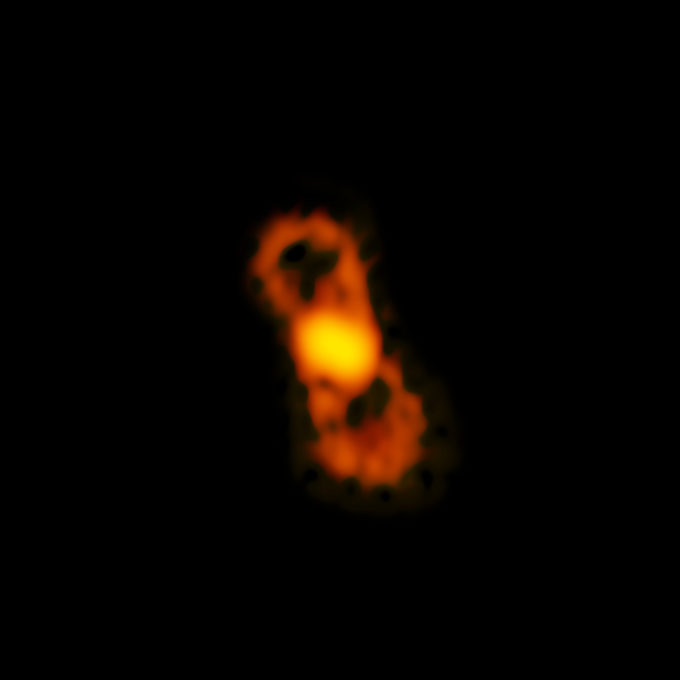
ALMA image of the radioactive molecule 26-aluminum monofluoride, as detected in CK Vul. Credit: ALMA (ESO/NAOJ/NRAO); NRAO/AUI/NSF; B. Saxton
More information
This research is presented in a paper titled “Astronomical detection of a radioactive molecule 26AlF in a remnant of an ancient explosion,” by T. Kamiński et al. in the journal Nature Astronomy.
The discovery involved the following telescopes/facilities: APEX, IRAM 30m, NOEMA, ALMA, and SMA. The most relevant observations were done with the PdBI/NOEMA interferometer and with the ALMA array, including its newly commissioned band 5 receiver.
The Atacama Large Millimeter/submillimeter Array (ALMA), an international astronomy facility, is a partnership of the European Organisation for Astronomical Research in the Southern Hemisphere (ESO), the U.S. National Science Foundation (NSF) and the National Institutes of Natural Sciences (NINS) of Japan in cooperation with the Republic of Chile. ALMA is funded by ESO on behalf of its Member States, by NSF in cooperation with the National Research Council of Canada (NRC) and the Ministry of Science and Technology (MOST) in Taiwan and by NINS in cooperation with the Academia Sinica (AS) in Taiwan and the Korea Astronomy and Space Science Institute (KASI).
ALMA construction and operations are led by ESO on behalf of its Member States; by the National Radio Astronomy Observatory (NRAO), managed by Associated Universities, Inc. (AUI), on behalf of North America; and by the National Astronomical Observatory of Japan (NAOJ) on behalf of East Asia. The Joint ALMA Observatory (JAO) provides the unified leadership and management of the construction, commissioning and operation of ALMA.
Contacts
-
Valeria Foncea
Education and Public Outreach Manager
Joint ALMA Observatory Santiago - Chile
Phone: +56 2 2467 6258
Cel: +56 9 7587 1963
Email: [email protected]
-
Charles E. Blue
Public Information Officer
National Radio Astronomy Observatory Charlottesville, Virginia - USA
Phone: +1 434 296 0314
Cel: +1 202 236 6324
Email: [email protected]
-
Richard Hook
Public Information Officer, ESO
Garching bei München, Germany
Phone: +49 89 3200 6655
Cel: +49 151 1537 3591
Email: [email protected]
-
Masaaki Hiramatsu
Education and Public Outreach Officer, NAOJ Chile
Observatory, Tokyo - Japan
Phone: +81 422 34 3630
Email: [email protected]
